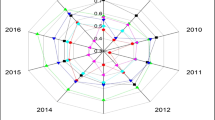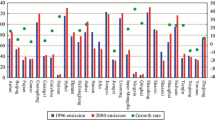Abstract
Using panel data of 30 provinces and new energy (NE)-listed enterprises in China from 2011 to 2020, this paper uses basic model to research the impact of various environmental policies in China on NE industry development firstly. Then, using economic level as a threshold variable, a threshold model was constructed to research the impact of economic level on the relationship between environmental regulation and NE industry development. The research results show that firstly, various environmental policies in China have significantly promoted the development of the NE industry. This is mainly manifested in two aspects. One is environmental regulations significantly increased the NE industry output value and profit, the other is environmental regulations enhanced the NE industry growth potential. Secondly, the regional economic level has a significant impact on the relationship between environmental regulations and NE industry development. The promotion effect of environmental regulations on NE industry development depends on the regional economic level. When the regional economic level exceeds the threshold, the promoting effect of environmental regulations on NE industry development significantly increases. The reason is that a weak economic foundation will affect investment in the NE industry. Insufficient capital investment will inevitably seriously hinder the development of the NE industry. Thirdly, residents’ education status, financial support, and NE industry agglomeration degree have a positive impact on the development of the NE industry, while population size has no significant impact on NE industry development.





Similar content being viewed by others
Data availability
Not applicable.
References
Ba Z, Zhao Y, Liu X, Li G (2022) Spatio-temporal dynamics and determinants of new energy policy diffusion in China: a policy citation approach. J Clean Prod 376:134270
Ba Z, Ma Y, Cai J, Li G (2023) A citation-based research framework for exploring policy diffusion: evidence from China’s new energy policies. Technol Forecast Soc Chang 188:122273
Bonsu NO (2020) Towards a circular and low-carbon economy: insights from the transitioning to electric vehicles and net zero economy. J Clean Prod 256:120659
Cang D, Chen C, Chen Q, Sui L, Cui C (2021) Does new energy consumption conducive to controlling fossil energy consumption and carbon emissions? Evidence from China Resources Policy 74:102427
Chai J, Tian L, Jia R (2023) New energy demonstration city, spatial spillover and carbon emission efficiency: evidence from China’s quasi-natural experiment. Energy Policy 173:113389
Che S, Wang J, Chen H (2023) Can China’s decentralized energy governance reduce carbon emissions? Evidence from new energy demonstration cities. Energy 284:128665
Cheng Z, Yu X, Zhang Y (2023) Is the construction of new energy demonstration cities conducive to improvements in energy efficiency? Energy 263:125517
Choi W, Yoo E, Seol E, Kim M, Song HH (2020) Greenhouse gas emissions of conventional and alternative vehicles: predictions based on energy policy analysis in South Korea. Appl Energy 265:114754
Cui Y, Khan SU, Li Z, Zhao M (2021) Environmental effect, price subsidy and financial performance: evidence from Chinese new energy enterprises. Energy Policy 149:112050
Dai Z, Luo Z, Liu C (2023) Dynamic volatility spillovers and investment strategies between crude oil, new energy, and resource related sectors. Resour Policy 83:103681
Engels A, Kunkis M, Altstaedt S (2020) A new energy world in the making: imaginary business futures in a dramatically changing world of decarbonized energy production. Energy Res Soc Sci 60:101321
Fang G, Gao Z, Sun C (2023) How the new energy industry contributes to carbon reduction? Evidence from China. J Environ Manage 329:117066
Farangi M, Soleimani EA, Zahedifar M, Amiri O, Poursafar J (2020) The environmental and economic analysis of grid-connected photovoltaic power systems with silicon solar panels, in accord with the new energy policy in Iran. Energy 202:117771
Gao R, Jiang J (2022) Design and implementation of environmental design based on new energy technology. Energy Rep 8:7600–7611
Gu Y, Ho K, Xia S, Yan C (2022) Do public environmental concerns promote new energy enterprises’ development? Evidence from a quasi-natural experiment. Energy Economics 109:105967
Guo J, Li X, Mu Y, Zhao F, Wu L, Yang H (2023a) A compound accumulation grey model and its prediction of new energy generation in BRICS countries. Energ Strat Rev 50:101221
Guo Y, Bruno G, Zhang D, Han K (2023b) Analysis of low-carbon technology innovation efficiency and its influencing factors based on triple helix theory: evidence from new energy enterprises in China. Heliyon 9(10):e20308
Hansen BE (1999) Threshold effects in non-dynamic panels: estimation, testing, and inference. J Econ 93(2):345–368
Huang Z, Huang L (2020) Individual new energy consumption and economic growth in China. North Am J Econ Finance 54:101010
Li Q, Wang M, Xiangli L (2021) Do government subsidies promote new-energy firms’ innovation? Evidence from dynamic and threshold models. J Clean Prod 286:124992
Lia J, Yao X, Sun G, Li J, Le W (2023) The impact of international carbon-related factors on China’s new energy market: based on different market conditions. Financ Res Lett 58:104496
Lib T, Shi Z, Han D, Zeng J (2023) Agglomeration of the new energy industry and green innovation efficiency: does the spatial mismatch of R&D resources matter? J Clean Prod 383:135453
Lin B, Zhang A (2023) Government subsidies, market competition and the TFP of new energy enterprises. Renewable Energy 116:119090
Liu F, Kang Y, Guo K, Sun X (2021) The relationship between air pollution, investor attention and stock prices: evidence from new energy and polluting sectors. Energy Policy 156:112430
Liu B, Zhang Q, Liu J, Hao Y, Tang Y, Li Y (2022a) The impacts of critical metal shortage on China’s electric vehicle industry development and countermeasure policies. Energy 248:123646
Liu P, Zhu B, Yang M, Chu X (2022b) ESG and financial performance: a qualitative comparative analysis in China’s new energy companies. J Clean Prod 379:134721
Luo G, Liu Y, Zhang L, Xu X, Guo Y (2021) Do governmental subsidies improve the financial performance of China’s new energy power generation enterprises? Energy 227:120432
Nematchoua MK (2021) Analysis and comparison of potential resources and new energy policy of Madagascar island; a review. Renewable Energy 171:747–763
Pan Y, Dong F (2022) Dynamic evolution and driving factors of new energy development: fresh evidence from China. Technol Forecast Soc Chang 176:121475
Partridge T (2020) “Power farmers” in north India and new energy producers around the world: three critical fields for multiscalar research. Energy Res Soc Sci 69:101575
Qu F, Chen Y, Zheng B (2021) Is new energy driven by crude oil, high-tech sector or low-carbon notion? New Evid High-Freq Data Energy 230:120770
Shen D (2021) Research on the sharing mode of educational information resources in colleges and universities based on the Blockchain and new energy. Energy Rep 7:458–467
Su Y, Yu Y (2020) Spatial agglomeration of new energy industries on the performance of regional pollution control through spatial econometric analysis. Sci Total Environ 704:135261
Sun C, Zhan Y, Du G (2020) Can value-added tax incentives of new energy industry increase firm’s profitability? Evidence from financial data of China’s listed companies. Energy Econ 86:104654
Tan C, Tan Z, Yin Z, Wang Y, Geng S, Pu L (2023) Study on grid price mechanism of new energy power stations considering market environment. Renewable Energy 203:177–193
Wang Q, Yi H (2021) New energy demonstration program and China’s urban green economic growth: do regional characteristics make a difference? Energy Policy 151:112161
Wanga G, Dang P, Li Y (2022) Research on the evaluation system of new energy development decision in Dunhuang city based on analytic hierarchy process. Energy Rep 8:129–135
Wangb G, Zhao Z, Tong W (2022) Construction and application of decision support indicator system for new energy development in Hexi Corridor. Energy Rep 8:187–193
Wen L, Guang F, Sharp B (2021) Dynamics in Aotearoa New Zealand’s energy consumption between 2006/2007 and 2012/2013. Energy 225(15):120186
Wen H, Lee C, Zhou F (2022) How does fiscal policy uncertainty affect corporate innovation investment? Evidence from China’s new energy industry. Energy Economics 105:105767
Wu Z, Fan X, Zhu B, Xia J, Zhang L, Wang P (2022) Do government subsidies improve innovation investment for new energy firms: a quasi-natural experiment of China’s listed companies. Technol Forecast Soc Chang 175:121418
Xie C, Wang Q (2022) Spatio-temporal characteristics of new energy industry innovation capability and impact factors analysis in China. Geographical Research 41:130–148. https://doi.org/10.11821/dlyj020210532. (in Chinese)
Xie L, Li Z, Ye X, Jiang Y (2021) Environmental regulation and energy investment structure: empirical evidence from China’s power industry. Technol Forecast Soc Chang 167:120690
Xu Z, Meng L, He D, Shi X, Chen K (2022) Government Support’s signaling effect on credit financing for new-energy enterprises. Energy Policy 164:112921
Yang X, Zhang J, Ren S, Ran Q (2021) Can the new energy demonstration city policy reduce environmental pollution? Evidence from a quasi-natural experiment in China. J Clean Prod 287:125015
Yuan J, An Y (2019) An empirical study on the impact of industrial policies on the growth of Chinese new energy enterprises. Study&exploration 6:151–155 (in Chinese)
Zhang R, Qie X, Hu Y, Chen X (2022) Does de-capacity policy promote the efficient and green development of the coal industry? Based on the evidence of China. Resour Policy 77:102717
Zhang Z, Zhang Y, Zhao M, Muttarak R, Feng Y (2023) What is the global causality among renewable energy consumption, financial development, and public health? New perspective of mineral energy substitution. Resour Policy 85:104036
Zhou W, Lu S, Chen J, Gou X (2020) How good or how poor have China’s new energy enterprises done: an empirical study based on the lagged double-market network. J Clean Prod 262:121284
Zhou A, Wang S, Chen B (2023) Impact of new energy demonstration city policy on energy efficiency: evidence from China. J Clean Prod 422:138560
Zhu X, Ma Y, Lanlan Kong, Yang J (2023) Understand consumers’ true views on new energy vehicles through behavioral reasoning and brand extension fit. Res Trans Bus Manag 49:100974
Acknowledgements
The authors would like to thank Shanxi Academy of Social Sciences of China for providing funding. This work was supported by the Shanxi National Social Science Foundation of China.
Funding
This work has received funding from the general project of Shanxi province social science foundation of China: “Research on strategies for promoting the development of Shanxi’s Specialized, Refined, and New enterprises” (approval number: 0404). The authors thank the Shanxi Academy of Social Sciences for this study support.
Author information
Authors and Affiliations
Contributions
This paper is a collaborative study by two authors. This paper was designed, tested, and written by Xiaohong Xiang. Wenting Wang participated in the research data collection and analysis, as well as the translation and revision of the paper. Authors are ranked by contribution. Therefore, there is no conflict of interest with any individual or organization. Other references have been noted and confirmed in this paper.
Corresponding author
Ethics declarations
Ethical approval
Not applicable.
Consent to publish
All the authors agree to publish this paper in this journal.
Consent to participate
Not applicable.
Competing interests
The authors declare no competing interests.
Additional information
Responsible Editor: Eyup Dogan
Publisher's Note
Springer Nature remains neutral with regard to jurisdictional claims in published maps and institutional affiliations.
This paper is completed by two authors. Other references have been noted and confirmed in this paper.
Rights and permissions
Springer Nature or its licensor (e.g. a society or other partner) holds exclusive rights to this article under a publishing agreement with the author(s) or other rightsholder(s); author self-archiving of the accepted manuscript version of this article is solely governed by the terms of such publishing agreement and applicable law.
About this article
Cite this article
Xiang, X., Wang, W. Economic level, environmental regulation, and new energy industry development. Environ Sci Pollut Res 31, 22814–22829 (2024). https://doi.org/10.1007/s11356-024-32610-9
Received:
Accepted:
Published:
Issue Date:
DOI: https://doi.org/10.1007/s11356-024-32610-9




